COVER STORY

Hadas Kress-Gazit. Photo: University Communications Marketing. See larger image
15. robots with better listening skills
Hadas Kress-Gazit, assistant professor of mechanical and aerospace engineering, is teaching robots to understand "natural language," turn it into the detailed instructions they need, and if necessary, tell their human handlers if there's a problem.
A software package called SLURP (Situated Language Understanding Robot Platform) starts by checking words in your command against a database of verbs and the qualifiers that go with them. For example, if you say, "Go to the kitchen and get me a glass of milk," it knows that "to" labels a destination for "go." The language processor hands off to software that converts the English words into steps in "linear temporal logic," a language that includes symbols for concepts like "until," "while," "always" and "never," which in turn lead to standard computer programming steps like "if … then," and the robot creates a short temporary program for the job it has to do.
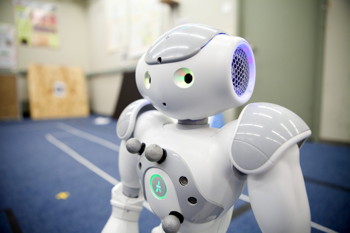
Robot used for natural language processing. Photo: University Communications Marketing. See larger image
Of course science fiction is full of uncooperative robots. "That does not compute" is a familiar catchphrase. The nonexpert robot handler needs that feedback to give better instructions or fix whatever might get in the way. Kress-Gazit's software runs through the steps the robot has planned and checks each one for feasibility. If there's a problem, it composes a natural language reply by combining part of the original command with a few words of explanation like, "I can't get you a glass of milk. We're out of milk." The robot also will check the actions against a list of rules: "I can't get you a glass of milk because the cat is sleeping in the hall and you told me never to frighten the cat."
The next step in the research will be to equip the robot to suggest solutions: "Do you want me to order milk?" By the time we have personal robots it might be, "The refrigerator has ordered milk; it should be delivered in about an hour." And by that time, cats will probably be used to robots.
– Bill Steele
16. how many butterflies have you really seen?

Monarch butterfly. Photo: Anurag Agrawal
Evolutionary ecologist Anurag Agrawal's idea was sparked in 2012 at the Monarch Biology and Conservation conference, which attracted some 200 butterfly enthusiasts – academics, conservationists and hobbyists.
There, participants debated two recently published yet conflicting papers: One study reported a decline of monarch populations over the past 18 years, while another study analyzed those same years but found no such declines. During discussions, Agrawal noticed that some participants disregarded science that didn't agree with their personal views.
That was when Agrawal first conceived of a project – funded by a 2013 Academic Venture Fund seed grant from Cornell's Atkinson Center for a Sustainable Future – to shed new insight on the debate of whether monarchs are indeed in decline, through a rigorous mathematical analysis of nearly 40 years of citizen science data of monarch counts in North America.
And with all censuses showing the last three years having the lowest monarch populations on record, Agrawal and colleagues hope to better understand the causes behind the population trends.
In addition, Agrawal will work with environmental sociologists (including Cornell faculty members Steven Wolf and Bruce Lewenstein) to clarify what the butterflies represent for people – how messaging about monarchs occurs, and how ambiguous scientific information is used by environmental organizations, for example.
Monarch butterflies have "become iconic because their story is so remarkable," including their cross-continental migrations, the toxins monarchs sequester from milkweeds, and their ubiquity in American childhoods, Agrawal says.
– Krishna Ramanujan
17. single-dose cure for disease
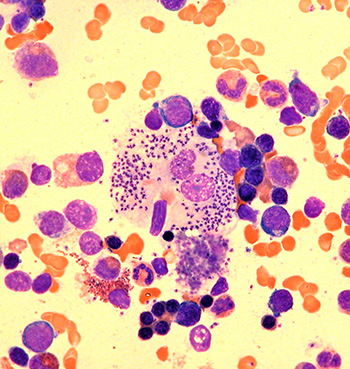
View of parasitized macrophage in bone marrow. Image: Henry Murray. See larger image
Henry Murray '68, M.D. '72, is an infectious disease and tropical medicine specialist and the Arthur R. Ashe Professor of Medicine at Weill Cornell Medical College. He has spent the last 30 years working on leishmaniasis, a parasitic infection found worldwide, particularly in India, that is spread human-to-human by the bite of sandflies.
Murray's life's work on leishmaniasis recently culminated in the development of two effective treatments for the disease.
In March, the U.S. Food and Drug Administration granted fast-track approval of oral miltefosine (trade name: Impavido), a treatment for the three forms of leishmaniasis that Murray's effort helped bring to clinical fruition. It is the first effective oral treatment for the disease.
But Murray's "Eureka!" moment happened in 2000; it has led to the single-dose intravenous treatment using liposomal amphotericin B (trade name: AmBisome) that has dramatically changed how the visceral form of infection is managed in the Indian subcontinent.
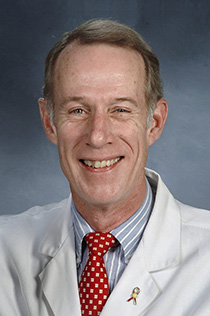
Dr. Henry Murray. Photo: Weill Cornell Medical College See larger image
Untreated visceral leishmaniasis is fatal. As many as two-thirds (about 200-250,000) of the world's new cases each year appear in a New England-sized region of the Indian subcontinent that includes the northeast state of Bihar, part of Bangladesh and southern Nepal, where it causes an estimated 20,000-25,000 deaths per year.
Visceral leishmaniasis (called kala-azar, "black fever," in the region) "has always been there in near- or true-epidemic form," Murray says. A treatment to greatly reduce or potentially eliminate the disease would need to be well-tolerated, highly effective and efficient, require no lab testing, guarantee 100 percent compliance and able to be administered in a rural health center setting. Tens of thousands of patients would need to be treated.
Lipid formulations of drugs, including liposomal amphotericin B, that came on the scene in the 1990s made it possible to target the actual cells in which the parasite multiplies. The treatment trials unit Murray helped to establish in India had already used this drug to dramatically improve and shorten kala-azar treatment from 28 to 5 days. Murray's idea was to find a way to roll the treatment into a single intravenous dose – a regimen that would need to be safe and as effective as multiple-dose therapy.
The first single-dose trials reached about a 90 percent cure rate (the acceptable benchmark is 95 percent). By the time of a third study, published in the New England Journal of Medicine in 2010, they had reached 96 percent.
"It took us 10 years to come up with a regimen which ultimately has changed the face of treatment in the Indian subcontinent," Murray says. Also gratifying: Murray's regimen is at the core of the National Kala-Azar Elimination Program shared by India, Bangladesh and Nepal; its goal is to essentially eliminate the disease, reducing its prevalence from 30-35 new cases per 10,000 population each year to fewer than 1.
– Joe Wilensky
18. love, not war

Image: Carla DeMello.
Why compete when we can collaborate?
That's the question Anne Kenney – Cornell's Carl A. Kroch University Librarian – asked in February 2009, after an unproductive meeting with a big group of research libraries.
All the libraries were slammed by a major recession, shrinking budgets, skyrocketing journal prices and increased demands for specialized content and expert librarians.
Later that year, Cornell and Columbia formed an unprecedented partnership between two Ivy League libraries: 2CUL – pronounced "too cool," for two libraries with the same "CUL" acronym.
Five years later, the two libraries collaborate on a range of initiatives, plans and programs, with support from The Andrew W. Mellon Foundation, and the partnership is working for both institutions.
Together, Cornell and Columbia are creating purchasing and licensing agreements to negotiate better deals with publishers and vendors; developing infrastructure to support sharing expertise and specialized subject areas; improving programming for humanities Ph.D. students; and developing strategies for preserving e-journals.
Cornell and Columbia students and faculty now have access to each other's physical facilities, so a Cornellian can get a Columbia library card, walk into Butler Library in Manhattan and borrow a book.
How's that for peace, love and understanding?
– Gwen Glazer
19. see music, hear architecture: a fruitful collaboration
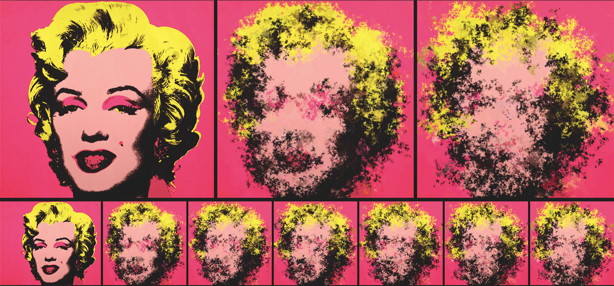
"after [no title] by Warhol, 1967" (2014), from Taylan Cihan and Andrew Lucia's exhibit "Portraits," which uses Lucia's algorithm to transform and reorder still images. Image: Andrew Lucia
Musician and doctoral candidate Taylan Cihan recently picked up some architectural blueprints and saw music.
They were the plans for a building designed by architect Andrew Lucia, a lecturer in the College of Architecture, Art and Planning – yet Cihan realized then that a blueprint is very much like a musical score.
"It is one hundred percent identical," he says, "a representation of a very complex phenomenon." A set of blueprints deals with material in much the same way that a musical score deals with sound.
Cihan and Lucia now work together to find common patterns and processes that underlie their different disciplines. Their groundbreaking ideas on musical and visual art have led to several fruitful collaborations.
The partnership started incidentally in 2012, when Lucia ran into some technical trouble with a sound visualization piece he was creating. Cihan helped him with the equipment needed to create a visual display from the sound of a viola de gamba quartet and liked the work he was doing.
"A couple weeks later," says Cihan, "we were playing our first show."
Their first live improv "noise" piece was presented during a Cornell Contemporary Chamber Players concert; in May 2012, the Cornell Symphony Orchestra premiered "An," a piece by Cihan accompanied by a visualization by Lucia.
To compose the piece, Cihan ran a violin bow across the edge of a cymbal, created a computer-aided spectral analysis of that sound and re-orchestrated it for symphony orchestra. To create the visual display, Lucia wrote an algorithm inspired by Cihan's process. The result was an evolving white, black and colored field whose edges dance like flames to the pulse of the music.
Their real creation, they said, is not the sound or the image but the generative process that creates both the visual art and the music.
The duo also shared their ideas with students by co-teaching a spring course, Sound and Image: Studies in Production and Affect, that challenged students to develop creative audiovisual projects.
– Kate Klein
20. shop global (for professors)
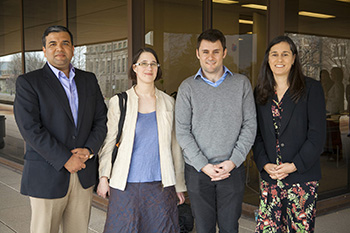
The first cohort of International Faculty Fellows: From left, Saurabh Mehta, Andrea Bachner, Daniel Selva and Victoria Beard. Photo: University Communications Marketing. See larger image
Infectious diseases; maternal and child health in Africa; community-based planning and poverty in Southeast Asia; theories of cultural differences in China; and the development of remote sensing satellites are at the heart of research by some of Cornell's most talented junior faculty. This summer, Saurabh Mehta, nutritional sciences (College of Human Ecology); Victoria Beard, city and regional planning (College of Architecture, Art and Planning); Andrea Bachner, comparative literature (College of Arts and Sciences); and Daniel Selva, mechanical and aerospace engineering (College of Engineering), begin three-year terms with the Mario Einaudi Center for International Studies as the first cohort of International Faculty Fellows (IFF).
They are expected to contribute to the intellectual life of Einaudi by hosting workshops in their fields of study. They will interact with various international programs housed within the center and enjoy opportunities to work across disciplines.
This new initiative is a centerpiece of Vice Provost for International Affairs and Einaudi Center Director Fredrik Logevall's "Call to Action: Advancing Cornell's International Dimension." It is meant to foster new collaborations between the colleges and the Einaudi Center, to enhance the connectivity of internationalization across campus, and to assist Cornell's colleges and schools with recruitment and retention of superb faculty whose research and teaching has an international focus.
– Laurie Damiani
21. the first metritis vaccine

Photo: Lexy Roberts See larger image
One of the most common cattle diseases, metritis, affects about a quarter of the roughly 9 million dairy cows in the United States and causes a domino effect of harm. Metritis sickens cows and makes them less productive; cuts into farmers' profits; and because of the widespread use of antibiotics to combat metritis, there is a serious impact on human public health: Antibiotics given to cows pollute the groundwater and milk supply and contribute to the growing epidemic of antibiotic resistance.
"Our lab has been developing a vaccine for years now based on our research of this disease," says Rodrigo Bicalho, assistant professor of dairy production medicine at the College of Veterinary Medicine.
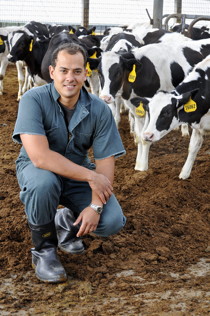
Rodrigo Bicalho. Photo: Stephanie Specchio. See larger image
Happily, the work has led to results even better than expected. Cornell scientists, with funding from Merck Animal Health, have created new vaccines that can prevent this infection of the uterus from taking hold and reduce its symptoms when it does, a prospect that could save the United States billions of dollars a year and help curb antibiotic resistance.
Metritis develops after a cow gives birth, when bacteria take advantage of the open vagina and cervix to settle in the uterus. Infected cows suffer fever, pain, inflammation, lack of appetite, depression and reduced reproductive abilities. It is the No. 1 cause of systemic antibiotic use. Three of the vaccines Bicalho's lab created decreased metritis incidence from 49 to 83 percent and lessened its symptoms when it did infect cows that received the vaccination.
"The powerful protection these vaccines produced surprised us. We expected some protective effect but nothing as strong as what we found," said Bicalho, who is working to move the vaccines toward USDA licensing.
– Carly Hodes
22. mentors matter
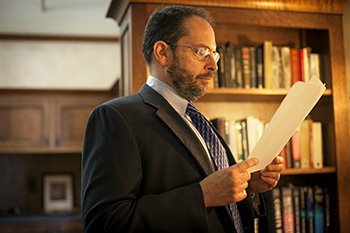
Jonathan Lunine with one of the letters he received from Carl Sagan when Lunine was a high school student. Photo: University Communications Marketing See larger image
Jonathan Lunine (pronounced Loo-NEEN) holds the David C. Duncan Professorship in the Physical Sciences, the chair once held by Carl Sagan. He is director of the Center for Radiophysics and Space Research and lead investigator on a mission to send a probe into Saturn's atmosphere. He also is a co-investigator on NASA space mission Juno and interdisciplinary scientist on Cassini. Last year, Lunine's work led to the first measurement of the depth (400 feet) of a liquid methane sea on Titan. Lunine is a science adviser to "Cosmos," the new Fox television series based on Sagan's 1980 PBS series.
In this interview with Ezra contributing editor Emily Sanders Hopkins, Lunine recalls that beginning in the 1970s, he and Sagan exchanged several letters:
So there I was in New York City. … My father died in 1974. He was an alcoholic. It was a pretty dark and dismal time. After every chapter [of Sagan's book "The Cosmic Connection"], I would go to my mother and say, "I need to read this part to you." She finally got fed up and said, "Why don't you write to him?" and I said … "Well, he wouldn't write back to me! He's a famous professor at Cornell and I'm just a high school student."
But I did write him a letter. Sometime later, I got a letter back from him. It was actually a package in a manila envelope, which I still have, and it contained the letter and two reprints of scientific articles on his studies of the Martian moons Phobos and Deimos with data from Mariner 9, the first mission to orbit Mars. I was thrilled.
I'd asked him how one could become an astronomer, what should you study in high school, and what are the good places to go to college to major in astronomy. And he wrote and told me all about what to do. … I then wrote to him a couple of more times. And he wrote me back.

Letters Carl Sagan wrote to Jonathan Lunine when Lunine was a high school student. See larger image
Unbeknownst to me, in 1987 my mother then wrote to [Sagan]. By that point I'd gone to college at Rochester and graduated with a Ph.D. from Cal Tech, and I was a faculty member at Arizona. And I think my mother couldn't contain her desire to write … to tell him I'd really become an astronomer. He wrote back to her. It's dated March 18, 1987.
Dear Mrs. Bean,
I want you to know how much I appreciate the letter you sent me last December. The accumulation of mail has now reached such a state in my office that I am not answering as many of the letters from younger versions of Jonathan Lunine as I should. And among many other things, your letter reminds me of the importance of finding ways to write to youngsters. I know and admire your son's planetary research sufficiently that we made a serious effort to attract him to an assistant professorship here at Cornell. And if I have helped inspire Jonathan and taught him something about planetary science, he has certainly returned the favor.
With warm good wishes, cordially,
Carl Sagan.
That letter is actually the one I treasure the most.
It was his unbridled visionary enthusiasm that transported so many people into the universe with Carl. … we are doing things today Carl envisioned and wished we could do: exploring planets around other stars, seeing if they have atmospheres suitable to support life, mapping seas of another world, discovering liquid water environments deep in the interiors of Saturnian moons … That which he imagined humankind could do and should do are the things that will carry us across many generations into the cosmos as a spacefaring species. Those of us inspired by Carl need to continue articulating that vision.
<<View entire story as one page>>